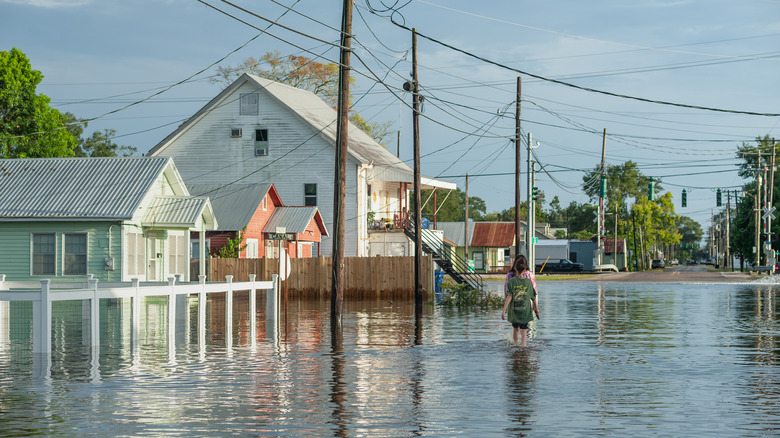How To Check And See If Your Home Is In A Flood Zone
Whether you're looking to purchase your forever home or rent a property for an extended period, it's always a good idea to check flood maps before signing any papers. If the property is prone to flooding, you might be left with endless headaches, expensive repairs, and damaged possessions. Insurance rates will also go up, so your new home may cost more than you initially anticipated. Plus, even if the risk of flooding may have been relatively low historically, a potentially at-risk location could cause issues in the future — particularly since extreme weather conditions are becoming more common, according to Live Science.
Unfortunately, the changing weather conditions have made it so that you won't be able to use older flood maps to determine your potential home's risk. Instead, you'll need to use the Federal Emergency Management Agency (FEMA)'s Risk Rating 2.0 system, which was recently updated to help homeowners understand the risk their property faces in light of recent weather developments.
Using FEMA's flood zone maps
Thankfully, FEMA's website makes it extremely easy to view a property's flood zone risk. If you enter an address into their Digital Flood Map, you'll be able to see exactly how high the risk of flooding is.
We're also beginning to see real estate websites import flood zone maps and similar metrics into their platforms. For example, listings on Realtor show a home's flood risk by comparing a couple of different flooding likelihood platform analyses, including FEMA's.
If you're curious about which areas seem to be increasing their odds of flooding, you can compare the difference between FEMA's old and new flood risk ratings on their website, which contains an interactive map and extensive list of spreadsheets that track changes across states, counties, and ZIP codes. These documents may help determine which areas have disproportionately increasing risks. While we wouldn't recommend living in an area just because the risk hasn't significantly increased (remember, the risk may have been high from beforehand), the metric might help you pick between two equally appealing locations.
Understanding the limitations
As we've all heard over the past few years, we live in unprecedented times. Since weather conditions will likely continue to worsen, there's a good chance that areas currently deemed safe by FEMA's Risk Rating 2.0 maps may have a higher risk of flooding as time goes on. It is entirely possible that FEMA will have to redraw maps in the future.
Of course, some areas are inevitably safer than others (and regions considered safe right now are probably the best future-proof bet). Plus, if you're looking at different homes today, chances are that you need to find somewhere to live — we aren't saying that you should hold off on moving indefinitely. That said, don't assume that your property's flood status will be indefinitely preserved. Make sure you set aside some money for unexpected costs in the future, even if it just goes towards insurance premiums.
The good news? According to the FEMA website, the agency was careful to stagger new financial burdens when they rolled out their new Risk Rating 2.0 system (which caused many homes to require additional insurance). If your home's risk does increase over the years, it's reasonable to expect that you'll be given a substantial heads up, allowing you a chance to adjust your finances.


